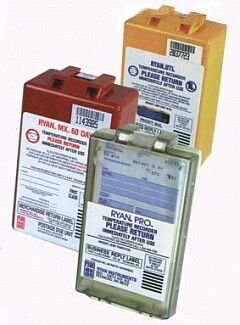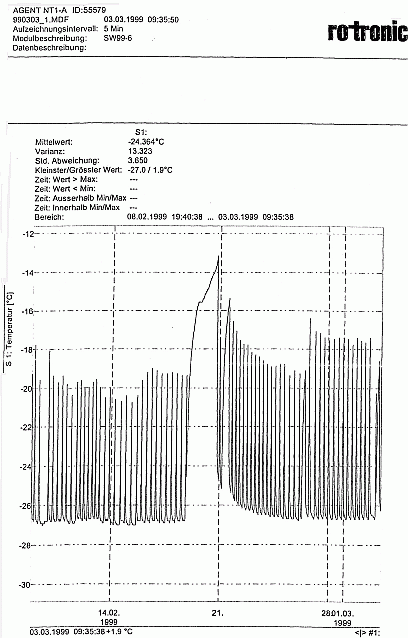 |
Figure 40: Mechanical and electronic Ryan recorders for recording temperatures in the load |
The devices currently available on the market are supplied by a number of manufacturers and range from clockwork-driven analog recorders that write data to a strip of paper right down to digital data loggers that use infra-red interfaces to transfer the data. Depending on the features,prices start at around $ 50 (valid 2000). The accuracy of the analog devices is approximately +/-1°C, and the digital devices are accurate to +/-0.1°C. Taking into account the value of the cargo and the potential costs of compensation for damaged goods, the cost of using a recorder is negligible and their use is to be recommended for all consignors. The recorded data is not only useful in providing the consignor with data as evidence against the transporter, but is also useful in providing evidence for mistakes made by third parties, for example, the terminals.
When choosing where to place these loggers, care should be taken to ensure that they are placed in temperature-critical locations in the container so that they measure the actual cargo temperature. It thus makes sense for them to be located in a box on the top layer close to the door.
Placing recorders of this type on top of the cargo is, however, not to be recommended as this measures the temperature of the air rather than the temperature of the cargo. This may give rise to far-reaching discussions about whether the cold chain has been maintained. Figure 41 shows an example of a record of this type. The clearly visible temperature peak in the middle of the printout shows an increase in temperature of approximately 10°C within the space of thirty minutes, but can only reflect a change in air temperature since it would not have been physically possible for the cargo temperature to have increased this much during this period of time because of its mass and the heat capacity of the cargo (see Section 8.4.3.1 for more information). A sharp increase in air temperature, as shown here, is perfectly possible in the event that the refrigeration system fails, since the air in the container very quickly starts to form layers where the warmest air is located just below the container roof.

Figure 41: Printout from an electronic data logger from Rotronic
placed in the cargo